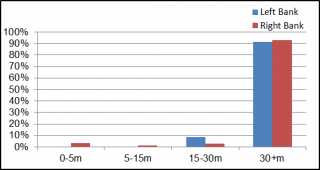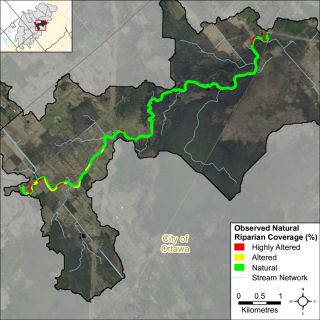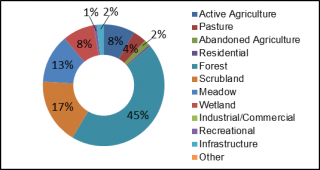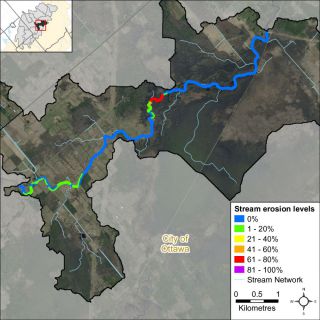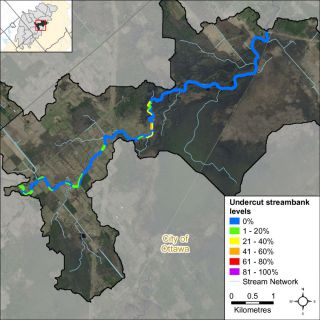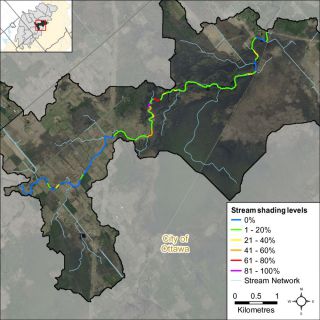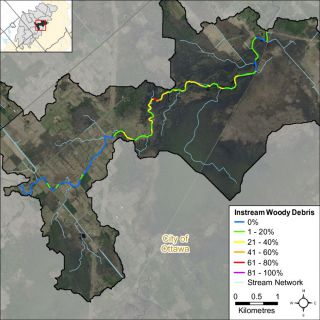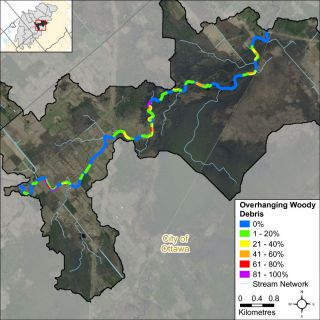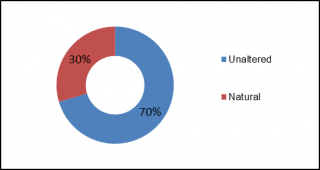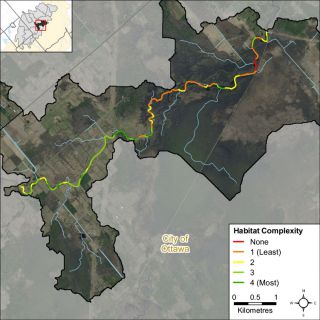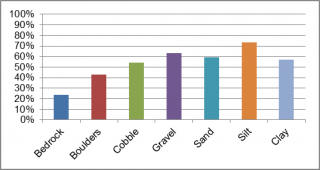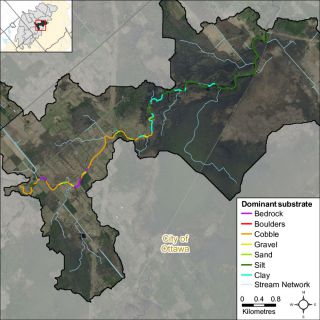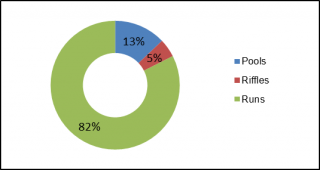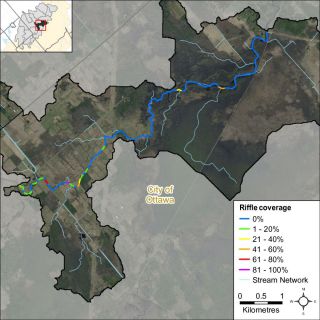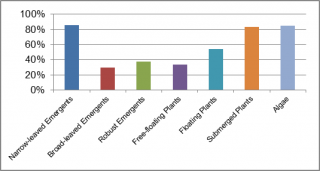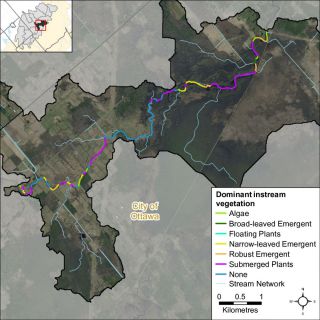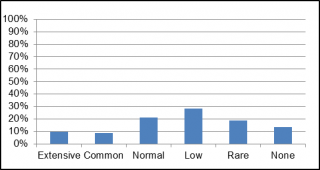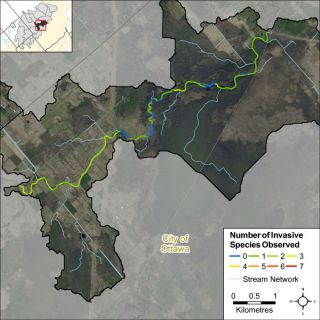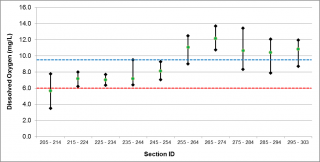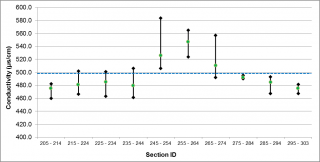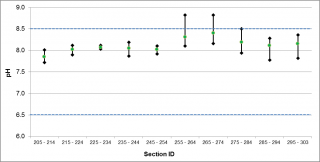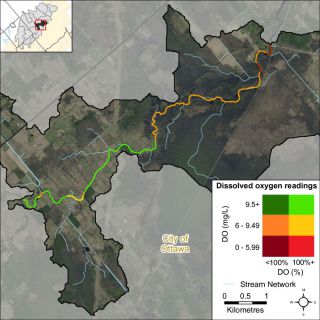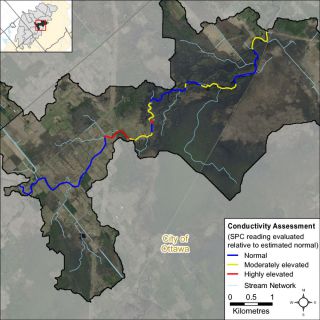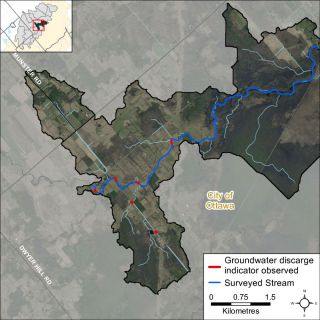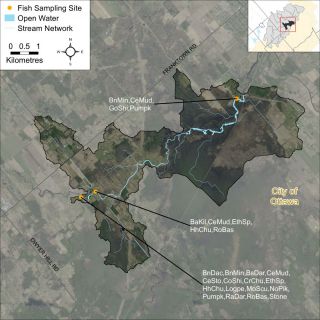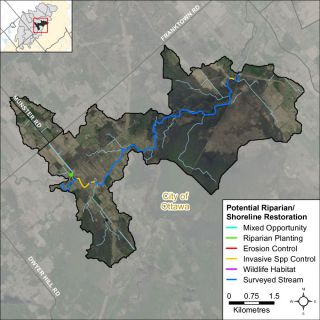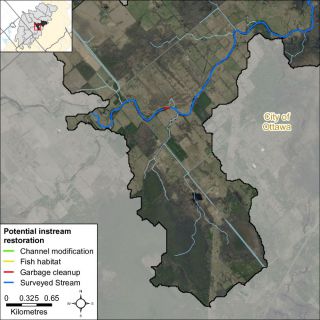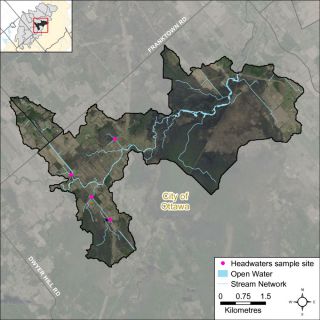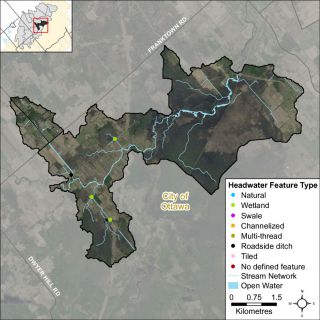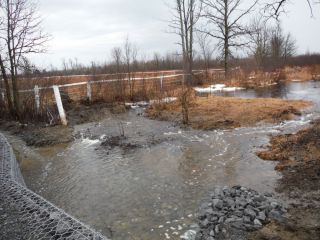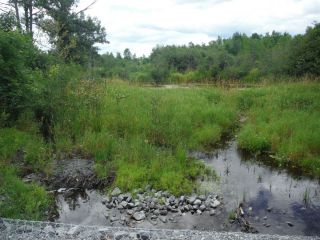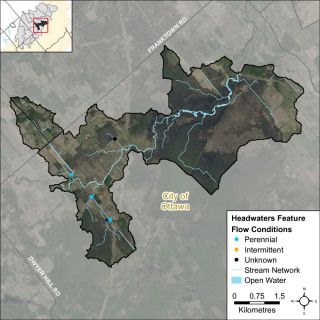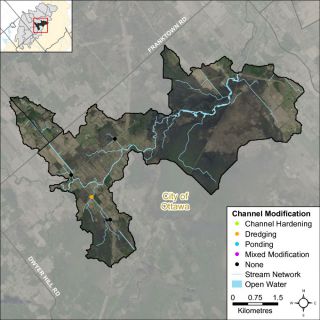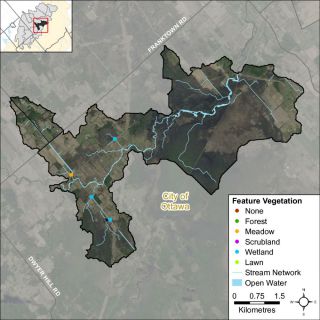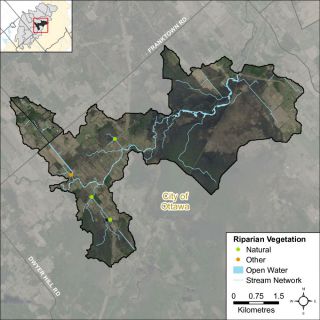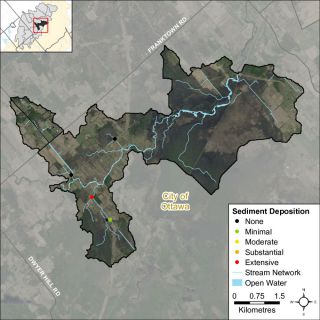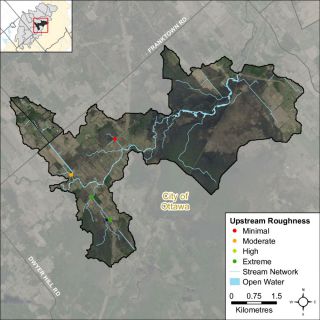2.0 Jock River-Richmond Fen Catchment: Riparian Conditions
2.1 Jock River Overbank Zone
2.1.1 Riparian Buffer Land Cover Evaluation
Figure 2 demonstrates the buffer conditions of the left and right banks separately. The Jock River in the Richmond Fen catchment had a buffer of greater than 30 meters along 93 percent of the right bank and 91 percent of the left bank.
2.1.2 Riparian Buffer Alterations
Alterations within the riparian buffer were assessed within three distinct shoreline zones (0-5m, 5-15m, 15-30m), and evaluated based on the dominant vegetative community and/or land cover type (Figure 3). The riparian buffer zone along the Jock River within the Richmond Fen catchment was found to have highly variable conditions along the riparian corridor. These alterations were generally associated with infrastructure in the form of railway, roads and agricultural land use.
2.1.3 Adjacent Land Use
The RVCA’s Stream Characterization Program identifies nine different land uses beside the Jock River in the Richmond Fen catchment (Figure 4). Surrounding land use is considered from the beginning to end of the survey section (100m) and up to 100m on each side of the river. Land use outside of this area is not considered for the surveys but is nonetheless part of the subwatershed and will influence the creek. Natural areas made up 83 percent of the stream, characterized by forest, scrubland, meadow and wetland. Forest habitat was dominant in the adjacent lands along the Jock River in the Richmond Fen catchment at 45 percent. The remaining land use consisted of active agriculture, pasture, abandoned agriculture, recreational and infrastructure in the form of railway and road crossings.
2.2 Jock River Shoreline Zone
2.2.1 Instream Erosion
Stream erosion is the process by which water erodes and transports sediments, resulting in dynamic flows and diverse habitat conditions. Excessive erosion can result in drastic environmental changes, as habitat conditions, water quality and aquatic life are all negatively affected. Bank stability was assessed as the overall extent of each section with “unstable” shoreline conditions. These conditions are defined by the presence of significant exposed soils/roots, minimal bank vegetation, severe undercutting, slumping or scour and potential failed erosion measures. The majority of the Jock River had no signs of erosion with the exception of the upper extent of the system which had low levels of erosion and one area in the middle reach had high levels of erosion observed. Figure 5 shows erosion levels along the Jock River in the Richmond Fen catchment.
2.2.2 Undercut Stream Banks
Stream bank undercuts can provide excellent cover habitat for aquatic life, however excessive levels can be an indication of unstable shoreline conditions. Bank undercut was assessed as the overall extent of each surveyed section with overhanging bank cover present. Figure 6 shows that Jock River in the Richmond Fen catchment had low to moderate levels of undercut banks along the system.
2.2.3 Stream Shading
Grasses, shrubs and trees all contribute towards shading a stream. Shade is important in moderating stream temperature, contributing to food supply and helping with nutrient reduction within a stream. Stream cover is assessed as the total coverage area in each section that is shaded by overhanging trees/grasses and tree canopy, at greater than 1m above the water surface. Figure 7 shows highly variable conditions of low to high levels of stream shading along the Jock River in the Richmond Fen catchment.
2.2.4 Instream Woody Debris
Figure 8 shows that the majority of Jock River in the Richmond Fen catchment had highly variable levels of instream woody debris in the form of branches and trees along the system. Instream woody debris is important for fish and benthic invertebrate habitat, by providing refuge and feeding areas.
2.2.5 Overhanging Trees and Branches
Trees and branches that are less than one meter from the surface of the water are defined as overhanging. Overhanging branches and trees provide a food source, nutrients and shade which helps to moderate instream water temperatures. Figure 9 shows the system is highly variable with low to high levels of overhanging branches and trees along the Jock River in the Richmond Fen catchment.
2.2.6 Anthropogenic Alterations
Stream alterations are classified based on specific functional criteria associated with the flow conditions, the riparian buffer and potential human influences. Figure 10 shows 70 percent of the Jock River in the Richmond Fen catchment remains “unaltered” with no anthropogenic alterations. Thirty percent of Jock River in the Richmond Fen catchment was classified as natural with minor anthropogenic changes. The alterations along the Jock River in this reach were in the form of reduced buffers and road crossings.
2.3 Jock River Instream Aquatic Habitat
2.3.1 Habitat Complexity
Habitat complexity is a measure of the overall diversity of habitat types and features within a stream. Streams with high habitat complexity support a greater variety of species niches, and therefore contribute to greater diversity. Factors such as substrate, flow conditions (pools, riffles) and cover material (vegetation, wood structure, etc.) all provide crucial habitat to aquatic life. Habitat complexity is assessed based on the presence of boulder, cobble and gravel substrates, as well as the presence of instream woody material.
Low to high habitat complexity was identified for the Jock River Richmond Fen reach (Figure 11). Regions with increased habitat complexity were observed in the upper reaches of the system within the catchment. The lower to middle reaches of the Jock River in the Richmond Fen catchment provide important wetland habitat.
2.3.2 Instream Substrate
Diverse substrate is important for fish and benthic invertebrate habitat because some species have specific substrate requirements and for example will only reproduce on certain types of substrate. The absence of diverse substrate types may limit the overall diversity of species within a stream. Figure 12 shows that 73 percent of the sections observed in the Jock River in the Richmond Fen catchment had the presence of silt substrate. Overall substrate conditions were highly diverse along the Jock River Richmond Fen reach with all substrate types being recorded along the reach. Figure 13 shows the dominant substrate type observed for each section surveyed along the Jock River in the Richmond Fen catchment. The map depicts the locations within the Richmond Fen wetland as being dominated by silt while the upper reaches of the Jock River within the catchment are dominated by cobble habitat.
2.3.3 Instream Morphology
Pools and riffles are important habitat features for aquatic life. Riffles are fast flowing areas characterized by agitation and overturn of the water surface. Riffles thereby play a crucial role in contributing to dissolved oxygen conditions and directly support spawning for some fish species. They are also areas that support high benthic invertebrate populations which are an important food source for many aquatic species. Pools are characterized by minimal flows, with relatively deep water and winter/summer refuge habitat for aquatic species. Runs are moderately shallow, with unagitated surfaces of water and areas where the thalweg (deepest part of the channel) is in the center of the channel. Figure 14 shows that the Jock River in the Richmond Fen catchment is highly variable; 82 percent consists of runs, 5 percent riffles and 13 percent pools. Figure 15 shows where the riffle habitat areas were observed along the Jock River in the Richmond Fen catchment.
2.3.4 Vegetation Type
Instream vegetation provides a variety of functions and is a critical component of the aquatic ecosystem. Aquatic plants promote stream health by:
- Providing direct riparian/instream habitat
- Stabilizing flows reducing shoreline erosion
- Contributing to dissolved oxygen through photosynthesis
- Maintaining temperature conditions through shading
For example emergent plants along the shoreline can provide shoreline protection from wave action and important rearing habitat for species of waterfowl. Submerged plants provide habitat for fish to find shelter from predator fish while they feed. Floating plants such as water lilies shade the water and can keep temperatures cool while reducing algae growth. Narrow leaved emergents were present at 86% of the sections surveyed, algae was observed in 85% of sections, while free floating plants were observed in 34% of surveyed sections. Broad leaved emergents were observed in 30% of sections, submerged plants in 84%, floating plants in 54% and robust emergents in only 38% of sections surveyed. Figure 16 depicts the plant community structure for the Jock River Richmond Fen catchment. Figure 17 shows the dominant vegetation type observed for each section surveyed along the Jock River in the Richmond Fen catchment.
2.3.5 Instream Vegetation Abundance
Instream vegetation is an important factor for a healthy stream ecosystem. Vegetation helps to remove contaminants from the water, contributes oxygen to the stream, and provides habitat for fish and wildlife. Too much vegetation can also be detrimental. Figure 18 demonstrates that the Jock River Richmond Fen reach had no vegetation to low levels of instream vegetation for 61 percent of its length. Normal to common levels of vegetation were recorded at 30 percent of stream surveys. Extensive levels were observed at 9 percent along the system.
2.3.6 Invasive Species
Invasive species can have major implications on streams and species diversity. Invasive species are one of the largest threats to ecosystems throughout Ontario and can out compete native species, having negative effects on local wildlife, fish and plant populations. Ninety three percent of the sections surveyed along the Jock River Richmond Fen reach had invasive species. The invasive species observed in the Jock River Richmond Fen reach were European frogbit, poison/wild parsnip, carp, banded mystery snail, yellow iris, bull thistle, Eurasian milfoil, Chinese mystery snail, and Manitoba maple. Invasive species abundance (i.e. the number of observed invasive species per section) was assessed to determine the potential range/vector of many of these species (Figure 19).
2.3.7 Water Chemistry
During the stream characterization survey, a YSI probe is used to collect water chemistry information. Dissolved oxygen (DO), specific conductivity (SPC) and pH are measured at the start and end of each section.
2.3.7.1 Dissolved Oxygen
Dissolved oxygen is a measure of the amount of oxygen dissolved in water. The Canadian Environmental Quality Guidelines of the Canadian Council of Ministers of the Environment (CCME) suggest that for the protection of aquatic life the lowest acceptable dissolved oxygen concentration should be 6 mg/L for warmwater biota and 9.5 mg/L for coldwater biota (CCME, 1999). Figure 20 shows that the dissolved oxygen in the Jock River Richmond Fen catchment was within the threshold for warmwater biota in this reach of the system. The average dissolved oxygen levels observed within the main stem of the Jock River Richmond Fen was 8.98mg/L which is within the recommended levels for warmwater biota.
2.3.7.2 Conductivity
Conductivity in streams is primarily influenced by the geology of the surrounding environment, but can vary drastically as a function of surface water runoff. Currently there are no CCME guideline standards for stream conductivity; however readings which are outside the normal range observed within the system are often an indication of unmitigated discharge and/or stormwater input. The average conductivity observed within the main stem of Jock River in the Richmond Fen catchment was 495.9 µs/cm. Figure 21 shows the conductivity readings for the Jock River in the Richmond Fen catchment.
2.3.7.3 pH
Based on the PWQO for pH, a range of 6.5 to 8.5 should be maintained for the protection of aquatic life. Average pH values for the Jock River Richmond Fen catchment averaged 8.12 thereby meeting the provincial standard (Figure 22).
2.3.7.4 Oxygen Saturation (%)
Oxygen saturation is measured as the ratio of dissolved oxygen relative to the maximum amount of oxygen that will dissolve based on the temperature and atmospheric pressure. Well oxygenated water will stabilize at or above 100% saturation, however the presence of decaying matter/pollutants can drastically reduce these levels. Oxygen input through photosynthesis has the potential to increase saturation above 100% to a maximum of 500%, depending on the productivity level of the environment. In order to represent the relationship between concentration and saturation, the measured values have been summarized into 6 classes:
- <100% Saturation / <6.0 mg/L Concentration. Oxygen concentration and saturation are not sufficient to support aquatic life and may represent impairment.
- >100% Saturation / <6.0 mg/L Concentration. Oxygen concentration is not sufficient to support aquatic life, however saturation levels indicate that the water has stabilized at its estimated maximum. This is indicative of higher water temperatures and stagnant flows.
- <100% Saturation / 6.0-9.5 mg/L Concentration. Oxygen concentration is sufficient to support warm water biota, however depletion factors are likely present and are limiting maximum saturation.
- >100% Saturation / 6.0-9.5 mg/L Concentration. Oxygen concentration and saturation levels are optimal for warm water biota.
- <100% Saturation / >9.5 mg/L Concentration. Oxygen concentration is sufficient to support cold water biota, however depletion factors are likely present and are limiting maximum saturation.
- >100% Saturation / >9.5 mg/L Concentration. Oxygen concentration and saturation levels are optimal for cold water biota.
Dissolved oxygen conditions on the Jock River in the Richmond Fen catchment are generally sufficient for both warm and coolwater species (Figure 23). Dissolved oxygen conditions are higher in the upper reach which is a function of the riffle habitat in those sections of the Jock River. Oxygen levels in wetland habitats are typically lower than they are in areas where the substrate is dominated by cobble and riffle habitat.
2.3.7.5 Specific Conductivity Assessment
Specific conductivity (SPC) is a standardized measure of electrical conductance, collected at or corrected to a water temperature of 25⁰C. SPC is directly related to the concentration of ions in water, and is commonly influenced by the presence of dissolved salts, alkalis, chlorides, sulfides and carbonate compounds. The higher the concentration of these compounds, the higher the conductivity. Common sources of elevated conductivity include storm water, agricultural inputs and commercial/industrial effluents.
In order to summarize the conditions observed, SPC levels were evaluated as either normal, moderately elevated or highly elevated. These categories correspond directly to the degree of variation (i.e. standard deviation) at each site relative to the average across the system.
Normal levels were maintained along the majority of the Jock River in the Richmond Fen catchment, with highly elevated areas immediately upstream of the Richmond Fen wetland and moderately elevated levels observed in the middle and lower reaches within the Richmond Fen (Figure 24).
2.3.8 Groundwater
Groundwater discharge areas can influence stream temperature, contribute nutrients, and provide important stream habitat for fish and other biota. During stream surveys, indicators of groundwater discharge are noted when observed. Indicators include: springs/seeps, watercress, iron staining, significant temperature change and rainbow mineral film. Figure 25 shows areas where one or more of the above groundwater indicators were observed during stream surveys and headwater assessments.
2.3.9 Fish Community
The Jock River Richmond Fen catchment is classified as a mixed community of warm and cool water recreational and baitfish fishery with 18 species observed. Figure 26 shows the sampling locations along the Jock River in the catchment.
The following table contains a list of species observed in the watershed.
| Fish Species | Fish code | Fish Species | Fish code |
|---|---|---|---|
| banded killifish | BaKil | golden shiner | GoShi |
| blacknose dace | BnDac | hornyhead chub | HhChu |
| blackside darter | BsDar | logperch | Logpe |
| bluntnose minnow | BnMin | mottled sculpin | MoScu |
| central stoneroller | CeSto | northern pike | NoPik |
| central mudminnow | CeMud | pumpkinseed | Pumpk |
| common shiner | CoShi | Rainbow darter | RaDar |
| creek chub | CrChu | rock bass | RoBas |
| etheostoma sp. | Ethsp | stonecat | Stone |
2.3.10 Riparian Restoration
Figure 27 depicts the locations of riparian restoration opportunities as a result of observations made during the stream survey.
2.3.11 Instream Restoration
Figure 28 depicts the locations of instream restoration opportunities as a result of observations made during the stream survey. Only one small stream garbage cleanup restoration opportunity was observed in the Ruchmond Fen catchment.
2.4 Headwater Drainage Features Assessment
2.4.1 Headwater Sampling Locations
The RVCA Stream Characterization program assessed Headwater Drainage Features for the Jock River subwatershed in 2015. This protocol measures zero, first and second order headwater drainage features (HDF). It is a rapid assessment method characterizing the amount of water, sediment transport, and storage capacity within headwater drainage features (HDF). RVCA is working with other Conservation Authorities and the Ministry of Natural Resources and Forestry to implement the protocol with the goal of providing standard datasets to support science development and monitoring of headwater drainage features. An HDF is a depression in the land that conveys surface flow. Additionally, this module provides a means of characterizing the connectivity, form and unique features associated with each HDF (OSAP Protocol, 2013). In 2015 the program sampled 4 sites at road crossings in the Jock River Richmond Fen catchment area (Figure 29).
2.4.2 Headwater Feature Type
The headwater sampling protocol assesses the feature type in order to understand the function of each feature. The evaluation includes the following classifications: defined natural channel, channelized or constrained, multi-thread, no defined feature, tiled, wetland, swale, roadside ditch and pond outlet. By assessing the values associated with the headwater drainage features in the catchment area we can understand the ecosystem services that they provide to the watershed in the form of hydrology, sediment transport, and aquatic and terrestrial functions. The headwater drainage features in the Richmond Fen catchment are primarily classified as wetland with one feature classified as a road side ditch. Figure 30 shows the feature type of the primary feature at the sampling locations.
2.4.3 Headwater Feature Flow
The observed flow condition within headwater drainage features can be highly variable depending on timing relative to the spring freshet, recent rainfall, soil moisture, etc. Flow conditions are assessed in the spring and in the summer to determine if features are perennial and flow year round, if they are intermittent and dry up during the summer months or if they are ephemeral systems that do not flow regularly and generally respond to specific rainstorm events or snowmelt. Flow conditions in headwater systems can change from year to year depending on local precipitation patterns. Figure 31 shows the observed flow condition at the sampling locations in the Jock River Richmond Fen catchment in 2015.
2.4.4 Feature Channel Modifications
Channel modifications were assessed at each headwater drainage feature sampling location. Modifications include channelization, dredging, hardening and realignments. The Jock River Richmond Fen catchment area had one site as having been recently dredged, while three locations had no channel modifications observed. Figure 32 shows the channel modifications observed at the sampling locations for Jock River Richmond Fen.
2.4.5 Headwater Feature Vegetation
Headwater feature vegetation evaluates the type of vegetation that is found within the drainage feature. The type of vegetated within the channel influences the aquatic and terrestrial ecosystem values that the feature provides. For some types of headwater features the vegetation within the feature plays a very important role in flow and sediment movement and provides wildlife habitat. The following classifications are evaluated no vegetation, lawn, wetland, meadow, scrubland and forest. Figure 33 depicts the dominant vegetation observed at the sampled headwater sites in the Jock River Richmond Fen catchment.
2.4.6 Headwater Feature Riparian Vegetation
Headwater riparian vegetation evaluates the type of vegetation that is found along the adjacent lands of a headwater drainage feature. The type of vegetation within the riparian corridor influences the aquatic and terrestrial ecosystem values that the feature provides to the watershed. Figure 34 depicts the type of riparian vegetation observed at the sampled headwater sites in the Jock River Richmond Fen catchment.
2.4.7 Headwater Feature Sediment Deposition
Assessing the amount of recent sediment deposited in a channel provides an index of the degree to which the feature could be transporting sediment to downstream reaches (OSAP, 2013). Evidence of excessive sediment deposition might indicate the requirement to follow up with more detailed targeted assessments upstream of the site location to identify potential best management practices to be implemented. Sediment deposition ranged from none to extensive for the headwater sites sampled in the Jock River Richmond Fen catchment area. Figure 35 depicts the degree of sediment deposition observed at the sampled headwater sites in the Jock River Richmond Fen catchment.
2.4.8 Headwater Feature Upstream Roughness
Feature roughness will provide a measure of the amount of materials within the bankfull channel that could slow down the velocity of water flowing within the headwater feature (OSAP, 2013). Materials on the channel bottom that provide roughness include vegetation, woody debris and boulders/cobble substrates. Roughness can provide benefits in mitigating downstream erosion on the headwater drainage feature and the receiving watercourse by reducing velocities. Roughness also provides important habitat conditions for aquatic organisms. Figure 36 shows the feature roughness conditions at the sampling location in the Jock River Richmond Fen catchment.
